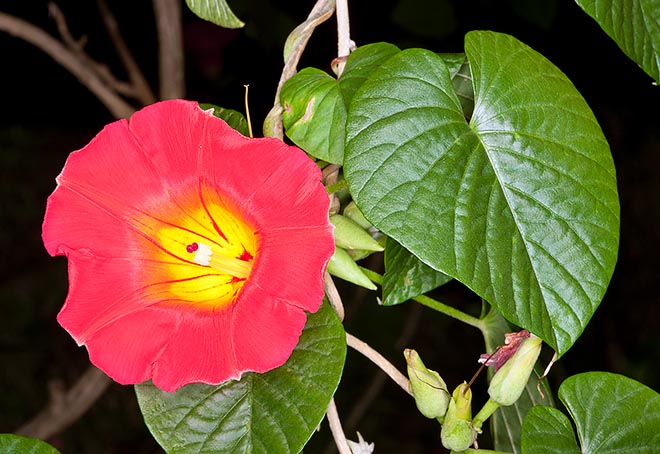Family : Convolvulaceae

Text © Pietro Puccio

English translation by Mario Beltramini

Stictocardia macalusoi is a showy tropical woody climber little cultivated © Giuseppe Mazza
The name of the genus is the combination of the Greek terms “stiktos” = dotted, and “kardia” = heart, with reference to the blackish glands on the cordate leaves of the type species; the species is honoured to the Italian agronomist Cesare Macaluso, director of the Agricultural Services of the Benadir Region (Somalia), at the beginning of the ‘900.
The Stictocardia macalusoi (Mat- tei) Verdc. (1961) is a perennial evergreen climber, woody, with alternate leaves, on a petiole up to about 8 cm long, ovate round with pointed apex, cordate base and entire margin, 7-11 cm long and 5-14 cm broad, dotted below by tiny blackish glands.
Inflorescences in axillary cymes, almost sessile, carrying numerous flowers, on a pedicel about 2,5 cm long, with calyx with 5 sepals, oblong with obtuse apex, 1,5 cm long and 1 cm broad, greater when in fruit, and campanulate corolla, 5,5-7 cm long, of orange colour bordered of red.
The fruits are globose indehiscent (not opening spontaneously when ripe) capsules, of 1,8 cm of diameter, surrounded by the persistent calyx, containing 4 globose-angulate seeds, blackish, slightly pubescent, about 0,7 cm long. It reproduces by seed, which is good to slightly scarify and to soak in water for one day, in order to facilitate its germination, before planting it in sandy soil, kept humid, at the temperature of 24-26 °C.
Very ornamental vigorous species, but rare in cultivation, cultivable in full sun in the tropical and subtropical climate zones, it seems that, when dry, it can stand for a very short period temperatures just under the 0 °C, with damage to the foliage; it requires soil particularly draining, possibly with addition of sand or other inert, and regular waterings in summer, spaced in winter, but without allowing the substratum to dry up completely. It can be utilized as a climber on gratings and pergolas as well as soil cover in desert gardens. Cultivable also in pot, utilizing sandy soil rich of organic substance, in an as much as possible luminous position, with winter lowest temperatures which is good not to drop under the 14 °C; it is easily subject to mites attacks.
Synonyms: Ipomoea macalusoi Mattei (1908).
→ To appreciate the biodiversity within CONVOLVULACEAE family please click here.
